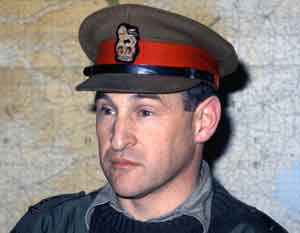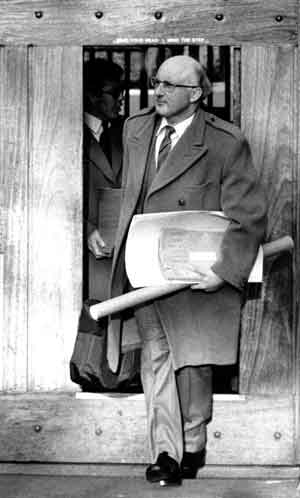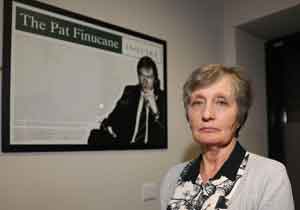AR LORG NA FÍRINNE—GAME OF TRUTH
Published in Issue 2 (March/April 2023), Reviews, Volume 31TG4, 14 December 2022
By Sylvie Kleinman

Above: The theorist on counter-subversion Brigadier Frank Kitson, who masterminded a bespoke strategy for Northern Ireland. (Victor Patterson)
‘Even before we buried our loved ones, the [British] State had buried the truth.’
For families of victims of bombings and murders during the Troubles, getting clarity about the circumstances behind the deaths of their relatives is not the same as finding peace. The NI Police Ombudsman cannot begin investigating half its case-load until 2028, owing to lack of funding, but families are willing to wait. Lack of resources, as this disturbing but very absorbing documentary demonstrates, is by no means the main impediment holding back ‘legacy’ investigations. It examines how information progressively filtered into the public domain about certain atrocities, proving collusion between the British State, its military and police and paramilitaries or ‘counter-gangs’; agents, too, were run in this ‘dirty war’. The ‘game’ behind the title aptly describes the protracted, heavily impeded and ongoing process to gain access to records and recover the truth, let alone proceed to prosecutions. Devastated by the loss of loved ones, who were ordinary people going about their daily lives when killed, families have for decades been victims of a system of ‘State-sponsored secrecy’, which to this day ‘shrouds the reasons’ why their relatives died. Trauma has been handed down the generations. We heard gripping testimonies from relatives: with great dignity, they outlined their disbelief at the layered revelations and official obstruction while conveying their grief. Moving on in their individual ways, some became intrepid campaigners and investigators themselves, like Ciarán MacAirt. At the macro level, there are fundamental and ongoing implications for democracy, as the British State has recognised that a ‘system’ had indeed been operating.

Above: Families found an unexpected ally in Colin Wallace, a former British military intelligence officer, seen here leaving Lewes Prison in December 1986 after his conviction for manslaughter had been quashed. (Alamy)
Game of Truth is longer than conventional documentaries, richly layered but densely packed; this review can only summarise. Animations re-enacting key events seem useful but are stiff and become annoying, and some facts, i.e. dates, need to be googled. The explosion at McGurk’s Bar in nationalist Belfast became a landmark example of media manipulation, deception and RUC ‘investigative bias’. ‘Dirty’ information was released and shaped the prevailing narrative that, illogically, an IRA bomb had accidentally detonated in the Catholic pub. It emerged, however, that the area had been under heavy surveillance, and a loyalist eventually confessed to planting the bomb, yet the victims were blamed as a result of this false implication, leading to the internment of Catholics. Four decades later, families found an unexpected ally in Colin Wallace, a former British military intelligence officer. The story builds steadily as we hear compelling explanations from a range of interviewees, while the human experience and perspective of the families continuously drive the narrative. Wallace had been involved in special covert ‘psychological’ operations, linked to MI5, to get at paramilitaries on both sides. We were progressing upwards in the chain of decision-making. He stated that, ‘According to wider government policy, we would have to change our information to reinforce government’. Enter the theorist on counter-subversion, (then) Brigadier Frank Kitson, who masterminded a bespoke strategy for Northern Ireland. Covert operations identified, infiltrated and undermined the enemy. He oversaw the dissemination of black propaganda, and his intelligence tactics are behind this multi-faceted legacy of a conflict which was anything but symmetrical, as intelligence searches spread to the local civilian population. In this Belgian, French and Irish co-production, a French security studies historian outlined that by 1976 practically 40% of Northern Irelanders were in Special Branch files. With computerisation, data could now be more easily processed. With its murky use of intelligence, the conflict is now internationally a historical case-study. This is hardly elevating, given the ‘psych war’ State agencies waged against its citizens.
Exceptional and highly controversial was the 1989 murder by the UDA of the solicitor Pat Finucane, thought to be in a protected profession but who had been openly, viciously threatened. The Stevens Report confirmed collusion between the military, Special Branch, loyalist paramilitaries and ‘agents’, or hit men, stating that Finucane’s killing could have been prevented. His son Michael outlined in Irish this ‘perfect system of assassination by proxy’, clearly uttering the last three words in English. Also demonstrated was official withholding of evidence: we looked over the shoulder of Finucane’s intrepid widow Geraldine, reading a heavily redacted file. After 23 years of campaigning, the Finucanes were invited to 10 Downing Street and told that the murder had been ‘horrendous’; collusion was not denied, yet the British State held back on a much-hoped-for inquiry.

Above: Geraldine Finucane, the intrepid widow of murdered solicitor Pat Finucane. (Liam McBurney/PA)
The bombing of Frizzell’s fish shop on the Shankill Road in 1993 was also deconstructed and crucially layered in how Protestants have been experiencing the eponymous game. The UDA was due to meet above the shop, and information trickled out that the authorities knew that the IRA was planning something. Gina Murray, whose thirteen-year-old daughter Leanne was killed, wanted to know the full truth: ‘they’ knew there were ‘people on the Shankill’. So could the atrocity have been stopped? In a brief and deeply moving scene from the play What if?, an imagined mother and daughter drift, upwards, hand in hand. Alan McBride lost his father-in-law and wife, leaving him with their two-year-old daughter. Sitting in a small memorial park, he was emphatic. He knew enough about the atrocity, but he would never trust the police again. The bludgeoning to death of Raymond McCord Jr was drug-related, ‘mafia-like’, and had nothing to do with the ‘cause’. The perpetrators were paid State police informers but remain protected by the State.
Frequent night scenes of driving around shadowy urban streets almost echo the grim and meandering process to access justice. Looking to the constantly evolving situation, hearing from Daniel Holder and Kevin Winters was vital. The Northern Ireland Troubles (Legacy and Reconciliation) Bill, as this review is submitted, is at committee stage in the House of Lords. Aimed at closing investigations and preventing legal actions, it has been universally opposed by victims groups and across the political divide in Northern Ireland. The UN Office of the Human Rights Commissioner deems that it ‘flagrantly’ contravenes rights obligations. Devoid of partisanship, the film clearly outlines for a general public the background to truth recovery, and the wider implications for State accountability, democracy and civil society.
Sylvie Kleinman is Visiting Research Fellow at the Department of History, Trinity College, Dublin.
















